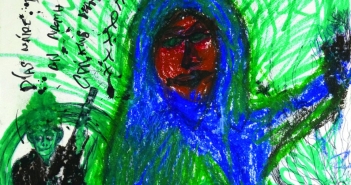Painters talk of the temperature of paint. It’s warm. It’s cold. There are colours that complement each other, others that do not. Colour is sensory. It is non-verbal and arguably pre-verbal, and gives us a framework for how to navigate and sublimate our visual surroundings. The grass is green, the ocean is blue, the sun is yellow.
To read colour in such an abrupt manner can make it seem static, rational even. Yet an artist can use colour as a strategic or manipulative tool, intentionally misleading and seducing the viewer with the hues and saturation of an artwork. The warmth of colours can be disarming like the hazy, golden yellows of a summer at dusk, or the rosy pinks of the evening as it shutters to a close. However, with painting, as in life, all is often not exactly what it seems. Much ugliness can be hidden beneath exquisite surfaces. Yet paradox lies at the heart of most art.
Desire, Melancholy and Loss
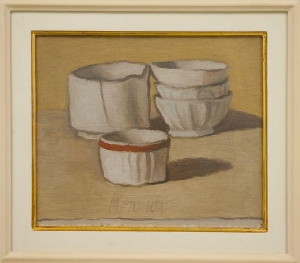
Giorgio Morandi
In September, I found myself standing before a painting by the Italian artist Giorgio Morandi, Natura Morta con tre tazze (1943), at the Museo Novecento in Milan, experiencing this tension first hand. In this painting stands three stacked bowls and a jug that looks to have just sidled up beside them.
The lips between the two forms connect, barely. A long dark shadowy line throws itself at the edges of where they meet. Its outline highlights the chasm that opens beneath them. It’s a strikingly intimate moment. In the foreground there is a third presence, another bowl which is situated at a remove from the other two, differentiated by the vibrant red stripe that, like a belt, contains it. An outsider perhaps? The palette of the paint is neutral, and the brushstrokes minimal. The red stripe is defiant. It penetrates.
There is an undoubtable tension between these objects, like watching one of Shakespeare’s plays, yet the mystery between them is left to the viewer. As my eyes move across the surface, peeling away the narrative layers I begin to feel the discord within me dissipate. Unmoored, I felt my internal structure begin to break apart. I became every object in that painting, if only briefly – a meditation on desire, melancholy and loss
Yet transcendence is a temporary state and once again the necessary coldness of reality was upon me. This distance is now filled with longing. The tears began to gather in my eyes. I waited a little longer and moved to the next painting.
Sacred Space
Morandi is regarded as one of the greatest painters of the last century. A mythology has been built up around him and the very particular process he employed to make his paintings. He safeguarded it with a religious fervour. His studio was a sacred space where he worked exclusively with the same everyday objects that he placed, assembled, and reordered until the setting and light was just right.
They were common objects jugs, mugs, bottles, their physical volume and shape lending them certain characteristics. They acted like players on a stage, the drama slowly unfolding before him, each arrangement offering a different narrative. When observing his paintings, one notices how the external signals are combined with his internal fears to create works that are silently directing us through the painful journey of existence. They are empty vessels in an empty landscape.
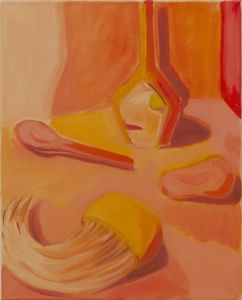
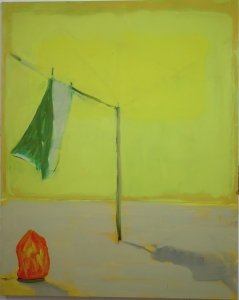
Human Frailty
The pandemic has thrown into light our human frailty, our need for connection, our surroundings and lived spaces. It has brought a metaphysical awareness to the things with which we surround ourselves. The domestic is now a sacred space and the quotidian is kingmaker.
Like Morandi, this sphere of the domestic is where I choose to situate my work. I create narrative vignettes culled from personal history, literature, music and film. At times these scenes seem banal, in others absurd. They are purely imagined spaces that are vague and elusive, offering fragmentary impressions of wonder, beauty, loneliness, and dread – and the duality that exists within us all.
My painting is both a language and alchemy. It is uncontainable, and oftentimes unpredictable with each work following its own logic. I use oil paint in a manner that reflects the sensibility of the oil itself. The surfaces of the painting have a diverse, formal vocabulary. At times I apply it with a quick, gestural abandon with the material sliding across the surface. At other times the paint is applied dry or diluted, methodically building layers and light through a process of application and wiping back.
Erasure is part of everything. A private performance where the traces are left behind on the canvas – residues of hair and dirt are solidified in time compressed.

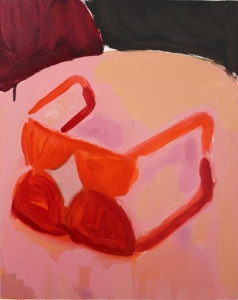
Moments Between
I aim to depict points in time where nothing much happens, and anxiety builds as our agency is suspended. Dramatic interludes are left to one side in favour of those moments between. We are deprived of that cathartic release. The scenes are at once familiar and yet there is a strangeness to them, an eeriness. The interiors are populated with objects, both uncanny and transcendent: a glove; an insect under a glass; a broken egg; a curtain shimmers; things are only half revealed.
Animals and figures sometimes appear yet they are more present in their absence. The objects seem to exist independent of our gaze. They carry on without us when left to themselves. They are ‘still lives’ in the conventional, historical sense. But now they have become autonomous figures. They too have become the players on the stage.
It is true that we cannot experience pleasure without first knowing pain; that we contain both true and false selves. One thing can be seen more clearly in relation to another. These polarities provide us with perspective and also uncertainty.
The psychoanalyst Donald Winnicott said that ‘artists are people driven by the tension between the desire to communicate and the desire to hide.’ The human condition is not a paradox to be solved but rather one to be lived. We should embrace the shadows within.
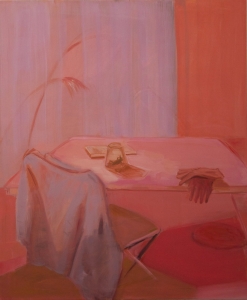
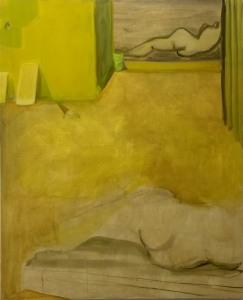
Images 1-6:
‘Objects of desire’ 40 x 50cm, 2020.
‘False Gods’ 120 x 150cm, 2019.
‘St. Lucy’, 25 x 35cm, 2019.
‘Sunglasses’ 31 x 39cm, 2019.
‘You can have it all’ 140 x 170cm, 2020.
‘Persona’, 120 x 150cm, 2020.
Feature Image: Andrea Wyner
Instagram: https://www.instagram.com/emilymannion1/?hl=en



